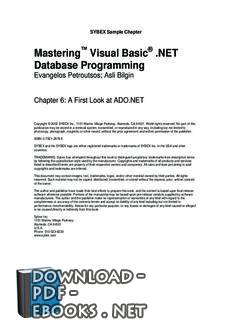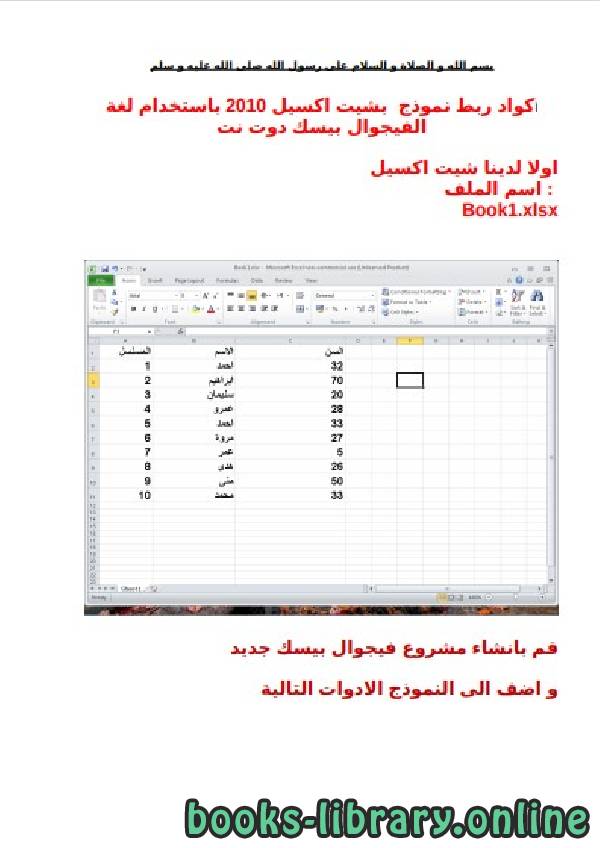كتاب Mastering™ Visual Basic® .NET Database Programming
Programming of databases using Visual Basic .NET 6 A First Look at ADO.NET How does ADO.NET work? Database Programming The Connection object The Command object The DataAdapter object The DataReader object The DataSet object Navigating through DataSets Updating Your Database by using DataSets Managing concurrency It’s time now to get into some real database programming with the .NET Framework components. In this chapter, you’ll explore the Active Data Objects (ADO).NET base classes. ADO.NET, along with the XML namespace, is a core part of Microsoft’s standard for data access and storage. As you recall from Chapter 1, “Database Access: Architectures and Technologies,” ADO.NET components can access a variety of data sources, including Access and SQL Server databases, as well as non-Microsoft databases such as Oracle. Although ADO.NET is a lot different from classic ADO, you should be able to readily transfer your knowledge to the new .NET platform. Throughout this chapter, we make comparisons to ADO 2.x objects to help you make the distinction between the two technologies. For those of you who have programmed with ADO 2.x, the ADO.NET interfaces will not seem all that unfamiliar. Granted, a few mechanisms, such as navigation and storage, have changed, but you will quickly learn how to take advantage of these new elements. ADO.NET opens up a whole new world of data access, giving you the power to control the changes you make to your data. Although native OLE DB/ADO provides a common interface for universal storage, a lot of : What are .NET data providers? What are the ADO.NET classes? What are the appropriate conditions for using a DataReader versus a DataSet? How does OLE DB fit into the picture? What are the advantages of using ADO.NET over classic ADO? How do you retrieve and update databases from ADO.NET? How does XML integration go beyond the simple representation of data as XML? Let’s begin by looking “under the hood” and examining the components of the ADO.NET stack.-
من كتب فجوال بيسك دوت نت كتب لغات البرمجة - مكتبة كتب تقنية المعلومات.

قراءة كتاب Mastering™ Visual Basic® .NET Database Programming أونلاين
معلومات عن كتاب Mastering™ Visual Basic® .NET Database Programming:
6
A First Look at ADO.NET
How does ADO.NET work?
Database Programming
The Connection object
The Command object
The DataAdapter object
The DataReader object
The DataSet object
Navigating through DataSets
Updating Your Database by using DataSets
Managing concurrency
It’s time now to get into some real database programming with the .NET Framework components.
In this chapter, you’ll explore the Active Data Objects (ADO).NET base classes. ADO.NET,
along with the XML namespace, is a core part of Microsoft’s standard for data access and storage.
As you recall from Chapter 1, “Database Access: Architectures and Technologies,” ADO.NET components
can access a variety of data sources, including Access and SQL Server databases, as well as
non-Microsoft databases such as Oracle. Although ADO.NET is a lot different from classic ADO,
you should be able to readily transfer your knowledge to the new .NET platform. Throughout this
chapter, we make comparisons to ADO 2.x objects to help you make the distinction between the
two technologies.
For those of you who have programmed with ADO 2.x, the ADO.NET interfaces will not
seem all that unfamiliar. Granted, a few mechanisms, such as navigation and storage, have changed,
but you will quickly learn how to take advantage of these new elements. ADO.NET opens up a
whole new world of data access, giving you the power to control the changes you make to your
data. Although native OLE DB/ADO provides a common interface for universal storage, a lot of
:
What are .NET data providers?
What are the ADO.NET classes?
What are the appropriate conditions for using a DataReader versus a DataSet?
How does OLE DB fit into the picture?
What are the advantages of using ADO.NET over classic ADO?
How do you retrieve and update databases from ADO.NET?
How does XML integration go beyond the simple representation of data as XML?
Let’s begin by looking “under the hood” and examining the components of the ADO.NET stack.
عدد مرات التحميل : 28153 مرّة / مرات.
تم اضافته في : الأربعاء , 13 يناير 2016م.
حجم الكتاب عند التحميل : 717.1 كيلوبايت .
تعليقات ومناقشات حول الكتاب:
ب 6
A First Look at ADO.NET
How does ADO.NET work?
Database Programming
The Connection object
The Command object
The DataAdapter object
The DataReader object
The DataSet object
Navigating through DataSets
Updating Your Database by using DataSets
Managing concurrency
What are .NET data providers?
What are the ADO.NET classes?
What are the appropriate conditions for using a DataReader versus a DataSet?
How does OLE DB fit into the picture?
What are the advantages of using ADO.NET over classic ADO?
How do you retrieve and update databases from ADO.NET?
How does XML integration go beyond the simple representation of data as XML?
Let’s begin by looking “under the hood” and examining the components of the ADO.NET stack.
 مهلاً !
مهلاً !قبل تحميل الكتاب .. يجب ان يتوفر لديكم برنامج تشغيل وقراءة ملفات pdf
يمكن تحميلة من هنا 'تحميل البرنامج'

نوع الكتاب : pdf.
اذا اعجبك الكتاب فضلاً اضغط على أعجبني و يمكنك تحميله من هنا:


كتب اخرى في كتب فجوال بيسك دوت نت

تكنولوجيا واجهة المعلومات في فيجوال بيسك دوت نت الجزء الرابع PDF
قراءة و تحميل كتاب تكنولوجيا واجهة المعلومات في فيجوال بيسك دوت نت الجزء الرابع PDF مجانا

الرسم والتلوين والصور والمجسمات لمبرمجي VB.NET PDF
قراءة و تحميل كتاب الرسم والتلوين والصور والمجسمات لمبرمجي VB.NET PDF مجانا

الفيجوال بيسك دوت نت ـ ترجمة كتابية لمحاضرات د . عاطف العراقي PDF
قراءة و تحميل كتاب الفيجوال بيسك دوت نت ـ ترجمة كتابية لمحاضرات د . عاطف العراقي PDF مجانا

العملاق في فيجول بيسك دوت نت 2008 من تأليف المبرمج أ. وائل قاسم سطيح PDF
قراءة و تحميل كتاب العملاق في فيجول بيسك دوت نت 2008 من تأليف المبرمج أ. وائل قاسم سطيح PDF مجانا

الفيجوال بيسك دوت نت ـ ترجمة كتابية لمحاضرات د . عاطف العراقي-الجزء الثاني PDF
قراءة و تحميل كتاب الفيجوال بيسك دوت نت ـ ترجمة كتابية لمحاضرات د . عاطف العراقي-الجزء الثاني PDF مجانا

حفظ الاعددات عند اغلاق البرنامج settings PDF
قراءة و تحميل كتاب حفظ الاعددات عند اغلاق البرنامج settings PDF مجانا



